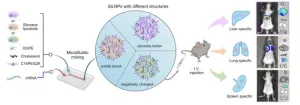(Press-News.org) PULLMAN, Wash. – To appeal to the majority of consumers, winemakers may want to pay as much attention to what’s on the bottle as what’s in it.
A three-part experimental study led by Washington State University researchers found that women were more inclined to purchase wine that had labels with feminine gender cues. The more strongly the participants identified with other women, a phenomenon called “in-group identification,” the greater this effect was. A feminine label also influenced their expectation that they would like the wine better.
With women representing 59% of U.S. wine consumers, the male-dominated field of winemaking might want to pay attention to the perceptions of this understudied group, said Ruiying Cai, lead author of the paper in the International Journal of Hospitality Management.
“When you look at the market segments, women are actually purchasing a lot of wine. They are a large group,” said Cai, an assistant professor with WSU’s Carson College of Business. “We found that feminine cues speak to women consumers. They have more favorable attitudes toward the label and the wine itself. They were also expecting their overall sensory experience to be better, and they were more likely to purchase the wine.”
Gender cues often rely on stereotypes, and in initial tests for this research, a group of 90 women rated wine labels as more masculine when they featured rugged animals like wolves and stags as well as portraits of men. They designated labels as feminine that had cute animals, flowers and female portraits. Labels with castles and bunches of grapes were seen as neutral.
In two online experiments, a total of 324 women were shown fictitious wines with labels designed with these gendered cues. The participants showed higher intention to buy wines with a feminine label, such as a woman holding flowers, as opposed to a wine with a masculine label, such as a bulldog in a spiked collar. When asked about the expected sensory experience, they rated their liking of every sensory aspect higher, including the color, taste, aroma and aftertaste.
The participant’s level of wine expertise moderated their taste expectations but surprisingly, not their purchase intentions.
“Whether they were knowledgeable or less knowledgeable about wine, when they saw those feminine cues, they had a higher intention to buy the wine. The gender cue influence was so strong, it trumped the effect of that knowledge,” said co-author Christina Chi, a professor at WSU’s Carson College of Business.
A third experiment with another set of 138 women involved a taste test—also with a surprising finding. Researchers gave bottles of the same red wine with one of the gendered labels. More women who tasted the feminine-labeled wine ranked it higher in fruit flavors such as red current and blueberry than those who tasted the same wine with a masculine-cued label—and despite the fact those flavors were not dominant components in that particular wine. Women connected more mineral flavors with the masculine-labelled wine.
However, the participants who tasted the feminine-labelled wine reported liking it less than the women who tasted the masculine-labelled wines. The authors said this could be a result of the incongruence between the expected flavor influenced by the feminine label and the actual taste of the wine sample, which had a medium body, tannin and alcohol level.
Few studies have focused on the perceptions of women wine consumers in a field where 82% of the winemakers are men. That lack of perspective is very apparent on wine aisles, said Chi, noting that many vintners seem to favor masculine imagery like stallions, bulls and roosters--and one brand even features a prisoner in a jail cell.
“When designing the labels, winemakers should involve more women in the process, and it’s highly advisable to pilot test the labels among consumers for gender cues,” she said.
In addition to Cai and Chi, co-authors on this study include recent WSU graduate Demi Deng now at Auburn University and Robert Harrington of WSU.
END
Women more likely to choose wine with feminine labels
2024-10-01
ELSE PRESS RELEASES FROM THIS DATE:
Understanding regional climate change is essential for guiding effective climate adaptation policy, study finds
2024-10-01
The effects of climate change are not distant future scenarios or confined to remote parts of the world—they are unfolding now, right in our own backyards. In 2023, extreme weather events impacted communities across every inhabited continent, causing major flooding, droughts, and wildfires.
While worldwide changes, such as increases in global mean temperature, often dominate discussions of mitigation actions, a detailed understanding of the regional impacts of a warming world is crucial for protecting communities from escalating risks. A team of researchers writing in Frontiers in Science synthesized results ...
New AI model efficiently reaches clinical-expert-level accuracy in complex medical scans
2024-10-01
UCLA researchers have developed a deep-learning framework that teaches itself quickly to automatically analyze and diagnose MRIs and other 3D medical images – with accuracy matching that of medical specialists in a fraction of the time. An article describing the work and the system’s capabilities is published in Nature Biomedical Engineering.
Unlike the few other models being developed to analyze 3D images, the new framework has wide adaptability across a variety of imaging modalities. The developers have studied it with 3D retinal scans (optical coherence tomography) for disease ...
Cool roofs could have saved lives during London’s hottest summer
2024-10-01
As many as 249 lives could have been saved in London during the 2018 record-setting hot summer had the city widely adopted cool roofs, estimates a new study by researchers at UCL and the University of Exeter.
The paper, published in Nature Cities, analysed the cooling effect that roofs painted white or other reflective colours would have on London’s ambient temperature between June and August 2018, the city’s hottest summer. From June through August, the average temperature around London was 19.2 degrees C, about ...
Solidarity drives online virality in a nation under attack, study of Ukrainian social media reveals
2024-10-01
While divisive social media posts get more traction in countries such as the US, a new study shows that celebrating national unity is the way to go viral in Ukraine.
“Ingroup solidarity” statements got far more likes and shares than hostile posts about Russians – a trend that only grew stronger in the wake of the invasion.
The first major study of social media behaviour during wartime has found that posts celebrating national and cultural unity in a country under attack receive significantly more online engagement than derogatory posts about the aggressors.
University of Cambridge psychologists analysed a total of 1.6 million ...
Research heralds new era for genetics
2024-10-01
UNDER STRICT EMBARGO UNTIL 10AM (UK TIME) ON TUESDAY 1 OCTOBER 2024.
Peer reviewed | Observational study | People
Research led by scientists at Queen Mary University of London is heralding in a new era for genetic sequencing and testing.
In the largest study of its kind to date, published today in Nature Medicine, an international group of researchers led by Queen Mary used new bioinformatics techniques to scan the genetic profiles of 80,000 people to understand the frequency of specific expansions of short repetitive DNA sequences in the general population.
These expansions are the most common cause of inherited neurological ...
Deep brain stimulation instantly improves arm and hand function post-brain injury
2024-10-01
Deep brain stimulation may provide immediate improvement in arm and hand strength and function weakened by traumatic brain injury or stroke, University of Pittsburgh School of Medicine researchers report today in Nature Communications.
Encouraging results from extensive tests in monkeys and humans open a path for a new clinical application of an already widely used brain stimulation technology and offer insights into neural mechanisms underlying movement deficits caused by brain injury.
“Arm and hand paralysis significantly impacts the quality ...
Siloxane nanoparticles unlock precise organ targeting for mRNA therapy
2024-10-01
Penn Engineers have discovered a novel means of directing lipid nanoparticles (LNPs), the revolutionary molecules that delivered the COVID-19 vaccines, to target specific tissues, presaging a new era in personalized medicine and gene therapy.
While past research — including at Penn Engineering — has screened “libraries” of LNPs to find specific variants that target organs like the lungs, this approach is akin to trial and error. “We’ve never understood how the structure of one key component of the LNP, ...
Building better solar cells: assembly of 2D molecular structures with triptycene scaffold
2024-10-01
Research in the field of material science and electronics relies on the innovative arrangement of molecules or atoms to develop materials with unique properties not found in conventional materials. Two-dimensional (2D) assemblies of π-electronic systems, arranged in thin layers, are becoming increasingly important in the fields of materials science and organic electronics. Their unique arrangement allows for specific electronic and physical properties, making them ideal for applications like solar cells, and flexible displays. However, creating such assemblies is challenging because it often requires special designs and techniques for each ...
Maybe we shouldn’t even call low-grade prostate cancer “cancer”
2024-10-01
A new paper in the Journal of the National Cancer Institute, published by Oxford University Press, indicates that patients may benefit if doctors stop calling certain early-stage changes to the prostate “cancer” at all.
Prostate cancer is the second leading cause of cancer death worldwide in men, but far more patients are diagnosed than die of the disease. In 2022, there were nearly 1.5 million cases of prostate cancer, but only 400,000 deaths. Low-grade prostate cancer, commonly known as GG1 among physicians, virtually never metastasizes or causes symptoms. Some medical researchers have wondered recently if it would be a benefit ...
‘Cheeky’ discovery allows scientists to estimate your risk of dying using cells found in the mouth
2024-10-01
We don’t all age at the same rate. But while some supercentenarians may age exceptionally slowly due to winning the genetics jackpot, a plethora of behavioral and lifestyle factors are known to speed up aging, including stress, poor sleep, poor nutrition, smoking, and alcohol. Since such environmental effects get imprinted on our genome in the form of epigenetic marks, it is possible to quantify molecular aging by characterizing the epigenome at prognostic genomic sites.
Over the past decade, scientists have developed several such ‘epigenetic clocks’, calibrated against chronological age and various lifestyle factors across large ...



